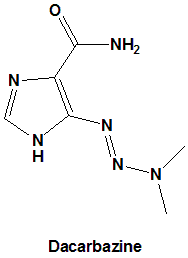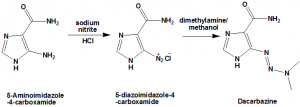DACARBAZINE Synthesis, SAR, MCQ,Structure and Therapeutic Uses
Dacarbazine (DTIC)
IUPAC nomenclature
5-(3,3-Dimethyl-1-triazenyl)imidazole-4-carboxamide

Classification
Dacarbazine falls under the category of Triazine alkalyting agents.
Physiochemical Properties
| S. NO. | PHYSICAL AND CHEMICAL PROPERTIES | |
| 1 | Molecular weight | 182.18 g/mol |
| 2 | Appearance | Ivory microcrystalline solid |
| 3 | Melting point | 205°C |
| 4 | Solubility | 1 mg per ml in water at NTP |
| 5 | Octanol water partition coefficient | -2.4 |
| 6 | Presence of ring | Imidazol ring |
Mechanism of Action
- Dacarbazine induces cytotoxicity in the cell through alkylation and thus, inhibition of DNA synthesis. DNA synthesis inhibition is done through purine analog and interaction with –SH groups.
- Further, it can be noted that dacarbazine having primary inhibitory action on RNA and protein synthesis and is activated in liver. [1]
Structural Activity Relationship
- 2-chloroethyl group is essential for the activity as the aziridine cation is formed by this only. Aziridine cation will attach with the alkylates of the DNA later.
- Binding with the amino group will increase the oral route availability of the drug
- The introduction of the substituted phenyl group will also increases the oral route availability of the drug.
- Aromatic ring introduction will increase the stability of the drug.
- Aromatic ring will further increase the distribution of the drug throughout the body.
- Benzimidazole ring can provide the local and faster action of the drug.
- Benzimidazol will further decrease the half life of compound.
Methods of Synthesis
i) 5-Aminoimidazole-4-carboxamide was treated with a 20% excess of sodium nitrite to give 5-diazoimidazole-4-carboxamide.
ii) 5-diazoimidazole-4-carboxamide is treated with anhydrous dimethylamine in methanol to give dacarbazine.

Therapeutic Uses
- Metastatic malignant melanoma
- Hodgkin’s disease
- Soft tissue sarcoma
- Neuroblastoma
- Fibrosarcoma
- Rhabdomyosarcoma
- Islet cell carcinoma
- Medullary carcinoma of thyroid gland
Side Effects
- Nausea, vomiting and poor appetites are common side effects.
- Chills, fever, numbness and tingling in hands and sensitivity to the sunlight are the less common side effects. [2]
MCQs
Q.1 Match the following drugs with correct IUPAC nomenclatures
| i. Carmustine | A. 5-(3,3-Dimethyl-1-triazenyl)imidazole-4-carboxamide
|
| ii. Lomustine | B. 1-(2-chloroethyl)-3-cyclohexyl-1-nitrosourea
|
| iii. Dacarbazine | C. 1,3-Bis(2-chloroethyl)-1-nitrosourea
|
| iv. Busulfan | D. Butane-1,4-diyl dimethanesulfonate
|
a) i-C, ii-B, iii-A, iv-D
b)i-C, ii-A, iii-D, iv-B
c)i-A, ii-B, iii-D, iv-C
d)i-C, ii-D, iii-B, iv-A
Q.2 How many statements below are true with respect to the SAR of the drug Dacarbazine?
- Aromatic ring introduction will increase the stability of the drug.
- Aromatic ring will further increase the distribution of the drug throughout the body.
- Benzimidazole ring can provide the local and faster action of the drug.
- Benzimidazol will further decrease the half life of compound.
a) 1
b) 2
c) 3
d) 4
Q.3 The drug Dacarbazine is found in which form
a) White crystalline powder
b) Reddish brown solid
c) Molten form at room temperature
d) Ivory microcrystalline solid
Q.4 The number of incorrect statements with respect to the method of synthesis of the drug Dacarbazine is?
- 5-Aminoimidazole-4-carboxamide can be the starting material for synthesis
- 5-Aminoimidazole-4-carboxamide is treated with sodium nitrite in presence of NaOH
- 5-Aminoimidazole-4-carboxamide is treated with sodium nitrate in presence of HCl
- 5-diazoimidazole-4-carboxamide is treated with anhydrous dimethylamine in methanol to give dacarbazine.
a) 1
b) 2
c) 3
d) 4
Q.5 Which amongst the following is not a therapeutic use of drug Dacarbazine?
a) Metastatic malignant melanoma
b) Hodgkin’s disease
c)Soft tissue sarcoma
d) None of the above
Q.6 The correct classification of the drug Dacarbazine can be?
a) Triazine alkylating agent
b) Nitrogen mustard alkylating agent
c) Ethylineimine alkylating agent
d) Alkyl sulfonate alkylating agent
Q.7 How many number of rings are found in the chemical structure of the drug Dacarbazine?
a) 1
b) 2
c) 3
d) 0
ANSWERS
1-a
2-d
3-d
4-b
5-d
6-a
7-a
References
[1] Erichsen C, Jönsson PE. Veno‐occlusive liver disease after dacarbazine therapy (DTIC) for melanoma. Journal of surgical oncology. 1984 Dec;27(4):268-70. [2] Ma C, Armstrong AW. Severe adverse events from the treatment of advanced melanoma: a systematic review of severe side effects associated with ipilimumab, vemurafenib, interferon alfa-2b, dacarbazine and interleukin-2. Journal of dermatological treatment. 2014 Oct 1;25(5):401-8.